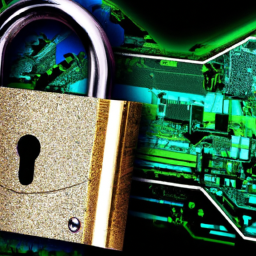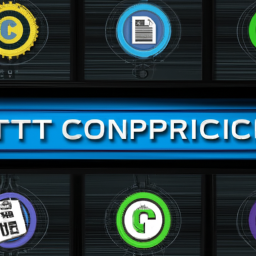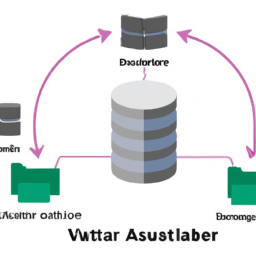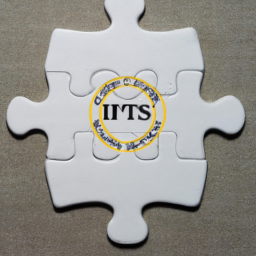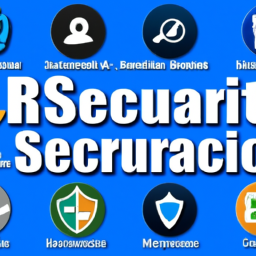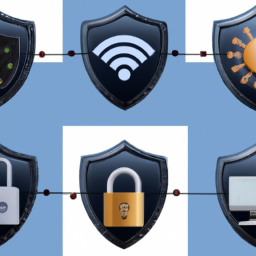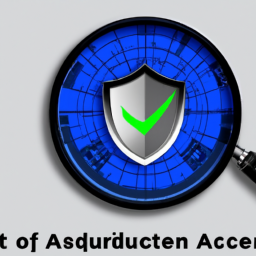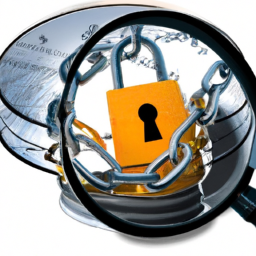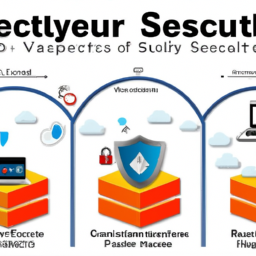In today’s rapidly evolving digital landscape, the role of cybersecurity professionals has become increasingly crucial. Just like the mighty walls of Troy that withstood the test of time, building a successful cybersecurity career requires a solid foundation and a strategic approach.
This article will provide you with invaluable tips and insights to navigate the complex world of cybersecurity and emerge as a sought-after professional in the field.
To begin your journey, acquiring the necessary technical skills and certifications is paramount. With cyber threats becoming more sophisticated by the day, staying updated on the latest trends and threats is also essential. Gaining practical experience through internships and hands-on projects will not only enhance your skillset but also give you a deeper understanding of real-world cybersecurity challenges.
Furthermore, developing strong analytical and problem-solving skills will enable you to identify vulnerabilities and devise effective solutions. Building a professional network in the cybersecurity community will open doors to new opportunities and collaborations. Lastly, continuously improving and updating your skills is vital to stay ahead in this ever-changing landscape.
So, let’s delve into the world of cybersecurity and unlock the secrets to a successful career.
Key Takeaways
- Acquiring necessary technical skills and certifications is paramount.
- Gaining practical experience through internships and hands-on projects enhances skillset.
- Developing strong analytical and problem-solving skills is important.
- Building a professional network in the cybersecurity community opens doors to opportunities.
Acquire the Necessary Technical Skills and Certifications
Acquiring the necessary technical skills and certifications is crucial for building a successful cybersecurity career. It is like pieces falling into place to form a solid foundation. To excel in this field, you must undergo rigorous technical training to understand the intricacies of networks, systems, and vulnerabilities. Gaining industry certifications, such as Certified Information Systems Security Professional (CISSP) or Certified Ethical Hacker (CEH), demonstrates your expertise and commitment to the field. These certifications validate your knowledge and proficiency, making you a desirable candidate for cybersecurity positions. Additionally, they provide a framework for continuous learning and professional development.
By investing time and effort into acquiring technical skills and industry certifications, you position yourself as a qualified and competent cybersecurity professional. Transitioning into the subsequent section about staying updated on the latest cybersecurity trends and threats, it is essential to remain vigilant in this ever-evolving landscape.
Stay Updated on the Latest Cybersecurity Trends and Threats
Staying in the loop with the ever-evolving world of cybersecurity is like navigating through a labyrinth of constantly shifting shadows, but it’s essential to keep your guard up against emerging threats and stay ahead of the game.
In the realm of cybersecurity, staying updated on the latest trends and threats is crucial for your career growth opportunities. The field of cybersecurity is constantly evolving, with new vulnerabilities and attack techniques emerging regularly. By staying updated, you can develop a deep understanding of current threats and trends, enabling you to better protect organizations from potential cyber-attacks.
Continuous learning in cybersecurity is of utmost importance, as it helps you adapt to evolving threats and technologies. Additionally, staying updated allows you to acquire new skills, certifications, and knowledge that are in demand in the industry. By doing so, you position yourself for potential promotions and higher positions within the cybersecurity field.
Keeping up-to-date with the latest trends and threats will help you gain practical experience through internships and hands-on projects, which we will discuss further in the next section.
Gain Practical Experience through Internships and Hands-On Projects
If you want to gain practical experience in the field of cybersecurity, seeking internship opportunities is a crucial step. Internships provide you with hands-on experience, allowing you to apply the knowledge and skills you’ve learned in a real-world setting.
Additionally, working on real-world cybersecurity projects gives you the opportunity to tackle actual challenges and develop essential problem-solving skills. By actively engaging in internships and hands-on projects, you can enhance your technical proficiency and gain valuable insights into the industry.
Seek Internship Opportunities in the Field
Explore internship opportunities in the field and you’ll discover firsthand the thrill of fighting cyber threats while gaining invaluable experience. Internships provide numerous benefits for aspiring cybersecurity professionals. They allow you to apply the knowledge gained in your academic studies to real-world scenarios, honing your skills and expanding your understanding of the field.
By working alongside experienced professionals, you can learn industry best practices and gain practical insights into the latest cyber threats and defense strategies. Additionally, internships provide an opportunity to network with professionals in the cybersecurity industry, potentially opening doors for future job opportunities.
When searching for internships, consider reaching out to local cybersecurity companies, government agencies, or universities for potential opportunities. Keep in mind that internships may be competitive, so it’s important to start your search early and tailor your application to showcase your relevant skills and enthusiasm for the field.
By securing an internship, you’ll be one step closer to working on real-world cybersecurity projects.
Work on Real-World Cybersecurity Projects
Get hands-on experience and develop your skills by working on real-world cybersecurity projects – how exciting would it be to tackle actual threats and defend against them? This is a crucial step in building a successful cybersecurity career.
Real world cybersecurity challenges are vastly different from textbook scenarios and require you to think on your feet, analyze complex situations, and come up with effective solutions. By working on industry specific cybersecurity projects, you will gain practical knowledge and a deeper understanding of the field.
You will encounter different types of threats and learn how to identify vulnerabilities, develop strategies to mitigate risks, and implement robust security measures. These experiences will not only strengthen your technical abilities but also enhance your problem-solving skills.
Transitioning into the next section, developing strong analytical and problem-solving skills will significantly contribute to your success in the cybersecurity field.
Develop Strong Analytical and Problem-Solving Skills
In order to excel in the field of cybersecurity, it’s essential for you to develop strong analytical and problem-solving skills. By learning to analyze and interpret data, you’ll be able to identify patterns and detect potential threats or vulnerabilities.
Additionally, practicing critical thinking and troubleshooting will enable you to effectively assess and resolve complex cybersecurity issues. These skills won’t only help you in your career but also contribute to creating a secure digital environment.
Learn to Analyze and Interpret Data
Mastering the art of data analysis and interpretation is crucial for anyone looking to thrive in the cybersecurity field. In this digital age, where vast amounts of data are generated every second, being able to effectively analyze and interpret this data is essential for identifying potential threats and vulnerabilities.
To excel in this area, consider the following:
- Learn to use specialized tools and software for data analysis.
- Develop a deep understanding of statistical analysis techniques.
- Stay updated with the latest trends and advancements in data analysis methods.
- Practice interpreting complex data sets and identifying patterns and anomalies.
- Enhance your skills in data visualization to effectively communicate your findings.
By honing your data analysis and interpretation skills, you will be better equipped to uncover hidden insights and make informed decisions in the realm of cybersecurity. This ability to analyze and interpret data will lay a solid foundation for the next step in building a successful cybersecurity career: practicing critical thinking and troubleshooting.
Practice Critical Thinking and Troubleshooting
Practicing critical thinking and troubleshooting is essential in the cybersecurity field, as it allows professionals to effectively analyze and solve complex issues.
For example, imagine a scenario where a company’s network is experiencing unusual traffic patterns and suspicious activity. By employing critical thinking skills, a cybersecurity analyst can investigate the source of the activity, identify potential threats, and develop a plan to mitigate the risks.
Critical thinking techniques involve evaluating evidence, identifying patterns, and making logical connections to reach informed conclusions.
Additionally, troubleshooting strategies play a crucial role in identifying and resolving technical issues. Cybersecurity professionals must possess a strong ability to troubleshoot network vulnerabilities, software malfunctions, and other potential security breaches.
By honing these skills, you will be better equipped to handle the challenges that arise in the cybersecurity field.
As you build a professional network in the cybersecurity community, these critical thinking and troubleshooting abilities will prove invaluable in collaborating and sharing knowledge with fellow experts.
Build a Professional Network in the Cybersecurity Community
To build a professional network in the cybersecurity community, you should join professional associations and organizations. These groups provide opportunities for you to connect with like-minded professionals, stay updated on industry trends, and access valuable resources and training.
Additionally, attending networking events and meetups is essential for expanding your network and fostering relationships with industry experts and potential employers. By actively participating in these activities, you can gain insights, share knowledge, and create opportunities for career advancement in the cybersecurity field.
Join Professional Associations and Organizations
By becoming a member of professional cybersecurity associations and organizations, you’ll gain access to a network of experienced professionals and cutting-edge resources to advance your career. Joining these associations is crucial for your professional growth in cybersecurity. Here are three reasons why:
-
Importance of mentorship in cybersecurity careers: Professional associations provide mentorship programs where experienced cybersecurity experts guide and support early-career professionals. This mentorship can help you navigate the complexities of the field and provide valuable insights and advice.
-
The role of continuous learning in professional growth in cybersecurity: Associations offer numerous opportunities for continuous learning, such as webinars, workshops, and conferences. These events allow you to stay updated with the latest trends, technologies, and best practices in the industry.
-
Access to job opportunities and collaborations: Being part of professional associations increases your visibility among potential employers and opens doors to job opportunities. Additionally, you can collaborate with other members on research projects, contributing to your professional reputation.
By joining these associations, you lay the foundation for a successful cybersecurity career.
In the subsequent section, we’ll discuss how attending networking events and meetups can further enhance your professional connections.
Attend Networking Events and Meetups
Attending networking events and meetups can be a game-changer in expanding your professional network and finding new opportunities. For example, imagine you attend a cybersecurity meetup and strike up a conversation with a senior professional who later introduces you to a job opening at a prestigious company. It is essential to leverage these networking strategies to build industry connections and enhance your career prospects.
Networking events and meetups provide a platform for like-minded professionals to come together, exchange ideas, and share their experiences. By actively participating in these events, you can gain valuable insights into the latest trends, technologies, and best practices in the cybersecurity field. Additionally, networking events often feature guest speakers who are experts in the industry, allowing you to learn from their expertise and expand your knowledge.
Moreover, networking events and meetups offer opportunities to connect with potential mentors, colleagues, and employers. Building relationships with professionals in the field can open doors to job opportunities, collaborations, and partnerships. It is crucial to make a lasting impression by introducing yourself, engaging in meaningful conversations, and exchanging contact information.
Incorporating a 2 column and 5-row table in markdown format:
| Benefits of Networking Events and Meetups | Networking Strategies |
|---|---|
| Expanding professional network | Engage in conversations with industry professionals |
| Discovering new opportunities | Actively participate in events and discussions |
| Gaining insights into industry trends | Attend presentations and guest speaker sessions |
| Learning from experts in the field | Seek out potential mentors and advisors |
| Building relationships with professionals | Follow up and maintain contact with connections |
Attending networking events and meetups can significantly contribute to your cybersecurity career. However, it is equally important to continuously improve and update your skills to stay competitive in the ever-evolving industry.
Continuously Improve and Update Your Skills
Always staying up-to-date with the latest cybersecurity trends and technologies is crucial for building a successful career in the field. In order to continuously improve and update your skills, follow these key strategies:
-
Pursue Continuous Learning: Cybersecurity is a rapidly evolving field, so it’s important to stay ahead of the curve. Take advantage of online courses, certifications, and workshops to expand your knowledge and stay current with new threats and technologies.
-
Improve Soft Skills: Technical skills alone aren’t enough to excel in cybersecurity. Developing strong communication, problem-solving, and teamwork skills will set you apart from other professionals in the industry.
-
Network and Collaborate: Engage with other cybersecurity professionals through forums, online communities, and social media. This won’t only help you stay informed but also enable you to exchange ideas and gain insights from others in the field.
-
Attend Industry Conferences: Participating in cybersecurity conferences and events provides valuable opportunities to learn from industry leaders, discover new tools and techniques, and expand your professional network.
By continuously improving and updating your skills, you’ll position yourself as a valuable asset in the cybersecurity field and increase your chances of building a successful career.
Frequently Asked Questions
How long does it typically take to acquire the necessary technical skills and certifications for a cybersecurity career?
Acquiring technical skills and certifications in cybersecurity can take anywhere from several months to a few years. While this may seem like a significant investment of time, it’s essential to remember the importance of continuous learning in this field.
Cybersecurity is constantly evolving, and staying up-to-date with the latest technologies and threats is crucial. By dedicating yourself to ongoing education and training, you’ll be better equipped to succeed in this dynamic and ever-changing industry.
What are some of the most common cybersecurity trends and threats that professionals should stay updated on?
To stay ahead in the cybersecurity field, it’s crucial for professionals to keep up with the ever-evolving cyber threats and trends.
Cybersecurity trends encompass the latest advancements in technology, such as cloud computing and Internet of Things (IoT), which bring both benefits and risks.
Additionally, emerging threats like ransomware, social engineering, and AI-powered attacks require constant vigilance.
By staying updated on these cybersecurity trends and emerging threats, professionals can proactively protect organizations and mitigate potential risks.
Are internships and hands-on projects the only ways to gain practical experience in cybersecurity, or are there other options available?
Internships and hands-on projects are not the only options to gain practical experience in cybersecurity. Simulation-based training is a valuable method to develop real-world skills in a controlled environment. It allows you to practice responding to cyber threats and testing your knowledge in a realistic setting.
Additionally, online courses provide a flexible and accessible way to learn about various cybersecurity concepts and techniques. These options enable you to acquire practical experience and enhance your skills in the cybersecurity field.
What are some effective strategies for developing strong analytical and problem-solving skills in the cybersecurity field?
To develop strong analytical and problem-solving skills in the cybersecurity field, focus on developing critical thinking abilities and identifying vulnerabilities.
Start by honing your ability to analyze complex situations and break them down into manageable components.
Additionally, familiarize yourself with various attack vectors and learn how to identify potential weaknesses in systems.
Practicing in simulated environments and participating in cybersecurity competitions can also enhance your problem-solving skills.
By continually challenging yourself and staying updated with the latest cybersecurity trends, you can become proficient in detecting and mitigating threats effectively.
How can individuals build a professional network in the cybersecurity community, especially if they are just starting their career?
To build a professional network in the cybersecurity community when starting your career, focus on attending industry conferences, workshops, and networking events.
Engage in online forums and social media groups dedicated to cybersecurity professionals. Connect with individuals who share similar interests and expertise. Actively participate in discussions, share your knowledge, and seek advice from experienced professionals.
Building a strong network will provide valuable connections, mentorship opportunities, and access to job openings in the cybersecurity field.
Conclusion
Congratulations! You’ve now armed yourself with the essential tools to conquer the world of cybersecurity. With your technical skills and certifications, alongside a keen eye for the latest trends and threats, you’re a force to be reckoned with.
But don’t stop there! Gain practical experience, hone your analytical and problem-solving skills, and build a powerful network in the cybersecurity community. Remember, the key to success is continuous improvement. So keep refining your skills and staying ahead of the game.
You’re ready to take on any cybersecurity challenge that comes your way. Let the world tremble in the face of your expertise!




